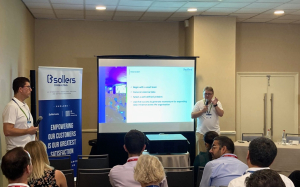
It’s hard to believe it’s already been a week since the 66th edition of the Rendez-Vous de Septembre in Monte Carlo, the largest gathering of reinsurance professionals in the world.
Among the biggest themes emerging from this year’s RVS are capacity challenges, the hardening market, Nat Cat events and AI. But one area we were particularly interested in was data, and how reinsurers are currently grappling with how to leverage good data for better, more active risk management. Luckily for us, our implementation partner, Sollers Consulting had prepared an excellent presentation for Tuesday morning.
Though it had been a late night for many following a guest appearance of Albert II, Prince of Monaco, at the official welcome party, data-hungry professionals congregated at the Fairmont to hear what Michal Trochimczuk and Krzysztof Biernat had to say.

Leveraging data in reinsurance
It was no surprise to us to hear from Michal that around 60% of insurance admin, life insurance and reinsurance processes are conducted through spreadsheets. They are the strongest tool in any reinsurer’s toolkit, but as the pace of change accelerates and losses get greater and the world becomes riskier, they are no longer fit for purpose. In the last three years alone, Nat Cat losses almost doubled worldwide. It’s now crucial for reinsurers to be able to perform better modelling, using the vast quantities and formats of data they receive. And spreadsheets quite simply are not up to the job.
Unstructured data is becoming a bigger challenge for reinsurers; the ingestion, assimilation and assessment of it is much more time-consuming, and more open to error than the structured data they’re used to. But it’s in this unstructured data: images, audio files, emails, Word-processed files, that rich information can be found, and the insights to fully model and mitigate risk. Sollers estimates that 80% of business data is currently in an unstructured format, yet most insurance systems are built to handle structured data.
Active risk management
As the world of risk changes considerably, reinsurers and insurers must start taking a more active role in risk management to try and mitigate their losses, but they can only do this with data, in all its forms.
Krzysztof explained and outlined the steps to active risk management. First, identify a new or emerging risk. Assess that risk, mitigate and then monitor it. He cited an excellent example of hailstorms in Switzerland, which were causing significant (and expensive) vehicle damage. To mitigate that risk, sensors have been deployed that can detect hail and send a warning to vehicle owners to take steps to protect them from damage. Identify. Assess. Mitigate. Monitor.
Beyond gathering and ingesting all the data needed to actively manage risk, reinsurers also need to be able to visualize and read it. The ability of systems to create comprehensive, easy-to-read reports is now paramount.
The team ended with a demo of some of the risk reporting, modelling and monitoring capabilities available to customers, helping them to keep on top of their own risk management processes and be better prepared for fluctuations in risk.
Is technology the key to smoother renewals?

We know first-hand how effective Sollers Consulting is in identifying and implementing innovative, valuable solutions to the insurance industry. They are one of our strategic partners supporting the successful deployment of our Underwriting Workbench to customers around the world.
Reinsurance carriers can use underwriting workbenches to accelerate their decision-making processes and work with real-time data, allowing them to adapt and respond to changing market conditions and review their portfolios in line with evolving broker and client discussions. Our Smart Submission product, for example, uses generative AI to extract data from submissions in any format and we work with leading data providers to enhance risk data, giving underwriters a fuller picture of the risk on their books.
As we move towards 1/1, just think how different 2024 renewals can be with advanced science supporting you.
For more information on Send Underwriting Workbench, and how it can support the reinsurance community, please click here.